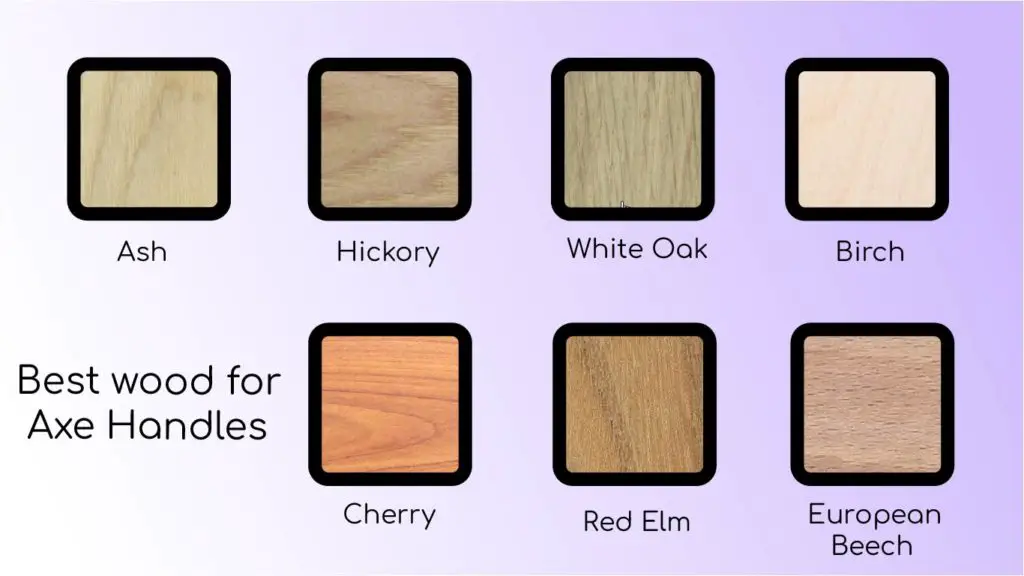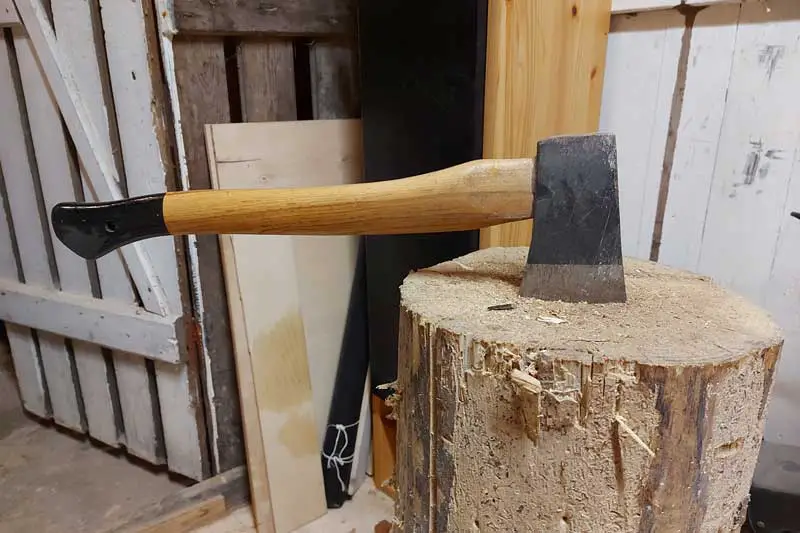Disclosure: This post may contain affiliate links, meaning I get a commission if you decide to make a purchase through my links, at no extra cost to you.
An axe has two main components, the handle, and the head. Both have to be of good quality and design if you want your axe to perform optimally. Using a poorly made axe with the wrong species of wood for the handle will take the fun out of chopping and will leave you exhausted in no time. So in this article, I will show you what wood you should consider for your next axe handle.
The best wood to use for an axe handle is Hickory. Hickory is generally regarded as the best wood for axe handles because of its combination of strength and flexibility. Hickory can handle massive shocks without breaking and has the right amount of flexibility which makes the axe efficient to work with.
Hickory is generally regarded as the best wood for axe handles, one of the main reasons is that it has been used for centuries and was highly valued by the loggers in the 1800’s. But Hickory is not the only option you have when you want a new handle for your axe. You actually have a lot of options, and woods with different properties and strengths. So let’s explore the best wood for axe handles.

What Is The Best Wood For An Axe Handle?
When we are looking for wood to make an axe handle out of, we are looking for certain characteristics of the wood.
We want the wood to be strong. When using an axe, we are hitting it as hard as we can against a fairly hard surface. We need the wood to be strong so it won’t break on us, breaking an axe can be dangerous and is annoying to deal with.
We want the wood to be durable. Most axes are made to last a long, the metal head can last for decades or even centuries if taken well care of. To get a durable axe handle we need wood that is resistant to rot, rain, and other environmental factors. We also want the axe to be durable in the sense that it can take a repetitive beating over long periods of time.
We want the wood to have the right amount of flexibility. With too much flexibility in the wood, the axe will produce less power. With too little flexibility in the wood, the axe is more prone to breaking on impact. Hickory is known for having the perfect amount of flexibility to use as an axe handle.
The handle has to feel and look good. Sometimes, an ax just feels right. You can feel the power, and the consistency when using it. Chopping with it feels good and all the stars are aligned. Sometimes it is hard to know why an axe feels right, it just does. It can be the wood, the look, the way it is shaped, the weight, or how it is balanced. But I suspect you will have a high chance of the axe feeling good if you use one of the woods below for your handle.
Hickory
Hickory is widely regarded as the best wood to make an axe handle out of. The wood is strong, has great shock-resistant capabilities, and has a good snap to it when chopping. This also makes the wood durable, a hickory axe handle can last you many years, if not decades.
Hickory is native to North America which makes it widely available at fairly cheap prices.
Hickory can be quite hard to work process compared to other wood on this list. It has a tendency to split and is really a hard wood with a Janka hardness rating of 1820 lbf. Be patient when working with hickory, especially if you are only using hand tools. Making your axe handle out of hickory is worth it when you see and use the finished product.
Another great feature of hickory wood is that it is straight-grained with few knots in the wood. This makes it easy to choose pieces for axe handles.
Ash
Ash is another great wood to use for an axe handle. Outside the United States, where hickory is not as widely available, Ash is the go-to wood when looking for axe handles. Ash grows throughout North America, Europe, and all the way to Turkey.
Ash handles can be described as springy, flexible, and light. You can feel that the wood is less dense than Hickory when using it, and it feels good. Ash is my personal favorite to use for axe handles.
Despite being light, Ash is a strong and durable wood and is highly shock resistant. But does not handle water well so it has to be treated regularly with linseed oil.
Ash is easy to work with, both with hand tools and power tools. Be aware that Ash can get burn marks easily when using power tools that produce a lot of friction
White Oak
White Oak is as strong as hickory, it is hard, durable, and resilient. It is a great option to use for an axe handle if you do not want to use the traditional woods like hickory or ash.
The downside of using white oak is that it is not very flexible. So you will have less of that snappy feeling when using it.
White oak grows mostly in eastern parts of North America and can be obtained at a fair price.
Oak requires a degree of finesse and patience when being worked with. Due to its heavy-grained structure, it has a tendency to chip away in bigger pieces if you are not careful. Use sharp tools and shape the wood carefully.
Oak also looks good, it has a beautiful grain pattern which makes for a stunning axe handle.

European Beech
Now we are getting into the more alternative types of woods to use for axe handles. The rest of the woods on this list is known for being woods that are used for axe handles, but they are not as widely used or normally sold commercially.
Beechwood has traditionally been used for axe handles for a long time in Europe. Don’t expect the elasticity and strength of Hickory when using wood from European Beech, but it does the job.
Beechwood is prone to insect attacks and rot. Axes with beech handles should be stored where it is safe from insects and changing moisture content.
Beechwood is easy to work with, it machines well, and responds well to glues and finishes.
European beech is readily available throughout Europe and can be obtained at a fair price. It can also be bought at most retailers for hardwood lumber.
American beech is weaker and more brittle than European Beech. I would not recommend using American beech for axe handles.
Cherry
Cherry is a favorite amongst many woodworkers. Not specifically as axe handles, but it is admired for its beauty and the wonderful red tint of the wood.
When using cherry for an axe, you are not going to get the strongest axe. And you are not going to get the most durable axe. But you can be sure that the handle is going to be a beauty.
Even though cherry is not the “best” wood for structural reasons. Cherry will still do the job of an axe fairly well and will probably last you for many years depending on the use.
Cherry is easy to work with and can both be used with hand and power tools. But use sharp tools so you don’t burn the wood.
Red Elm
Red Elm is a great option to use for an axe handle if you can find straight pieces of wood to make it from.
Red Elm can be hard to work because the grain is interlocked. The wood is prone to splitting and tearing out. But if you can get through the process of making an axe handle with Red Elm you will have a strong and beautiful end product.
If you are making your first axe, I would not recommend Red Elm. Red Elm is a great wood to increase the possibilities when advancing in axe making. But unnecessarily hard to work with for a beginner woodworker.
Birch
Birch is commonly used for axe handles throughout northern Europe. Birch is softer, more brittle, and less durable when we compare it to hickory. But that does not mean it can’t be used.
Birch is best to use for smaller axes handles and not for tree-felling axes or splitting axes. Since its mechanical abilities are not the best.
But if you have a straight-grained, knot-free, and well-seasoned piece of birch. It will make for a great axe handle.
Another great thing about birch is that it is a pleasure to work with, both with hand tools and power tools.
Last Words
Hopefully, this list will make it easier for you to choose which type of wood you want to use for your next Axe handle. Now go out and make something beautiful and strong. I believe in you

